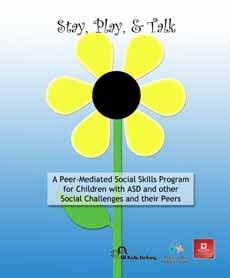
Stay, Play & Talk: A Peer-Mediated Social Skills Program for Children with ASD and Other Social Challenges and Their Peers
Have you been searching for a way to teach your classroom about inclusivity, perhaps as part of character education? Is one of your goals to educate your students about how we are all equal, yet with differences that should be celebrated? Have you been wondering how to teach the early learners in your inclusive classroom about how to interact with one another, especially those students who find social skills challenging? Have you been considering how to take a step back and let your students with autism spectrum disorders (ASD) learn directly from the interactions of peers? If so, a locally developed option is Stay, Play & Talk: A Peer-Mediated Social Skills Program for Children with ASD and Other Social Challenges and Their Peers.
Stay, Play & Talk, originally created as part of a buddy-skills training program for young children by K. English et al. (1997), has been collaboratively adapted by London, Ontario’s All Kids Belong, Thames Valley Children’s Centre, and Fanshawe College. This adaption has resulted in a complete program to assist three- to five-year-old early learners with diversity awareness, providing specific teaching and tools to assist young learners to interact successfully with children with ASD and other social challenges.
The instructional manual is organized in an easy-to-follow format with a complete program included. The contents provide information, lesson planning – even specific scripting for educators – in the following five areas, followed by references: Introduction (including a research supplement)
• Preparing the Environment & Children (including how to choose appropriate peers)
• Diversity Awareness (e.g., student activities)
• Stay, Play, & Talk (e.g., lessons on exactly how to stay, play, and talk with your friends)
• Fostering Peer Interactions (including varied teaching strategies).
Following these specifics is a set of full-colour appendices with fully prepared games, songs, posters, pictures, props, reinforcement examples, and samples of home-communication letters, making this manual a readyto- use tool for classroom teachers and early childhood educators. In addition, the contents of the printed appendices are provided on a CD, tucked into a pocket of the program binder. The entire binder can be purchased at cost through Thames Valley Children’s Centre in London.
Kimberly Maich is a former member of Elementary Teachers of Greater Essex who spent most of her career as a K–12 resource teacher. She is now an assistant professor of special education in the Faculty of Teacher Education at Brock University.